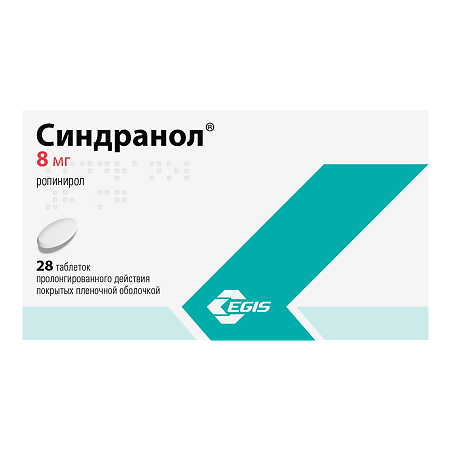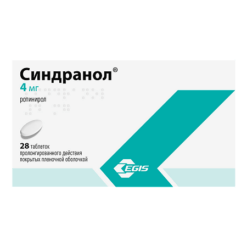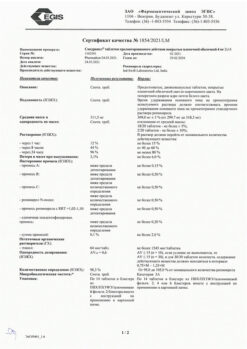No products in the cart.
Sindranol, 8 mg 28 pcs.
€75.53 €62.94
Out of stock
(E-mail when Stock is available)
Description
Parkinson’s disease:
– Monotherapy for early stages of the disease in patients requiring dopaminergic therapy to delay prescription of levodopa drugs.
– As combination therapy in patients receiving levodopa drugs to improve levodopa efficacy, including control of fluctuations in levodopa therapeutic effects (on-off phenomenon) and “end-of-dose” effects on chronic levodopa therapy, and to reduce daily levodopa dosing.
Indications
Indications
Parkinson’s disease:
– monotherapy in early stages of the disease in patients requiring dopaminergic therapy to delay the administration of levodopa.
– as a combination therapy in patients receiving levodopa preparations, in order to increase the effectiveness of levodopa, including control of fluctuations in the therapeutic effect of levodopa (the “on-off” phenomenon) and the “end-of-dose” effect during chronic levodopa therapy, as well as in order to reduce the daily dose of levodopa.
Pharmacological effect
Pharmacological effect
Antiparkinsonian drug – dopamine agonist
Special instructions
Special instructions
Given the risk of developing arterial hypotension in patients with severe cardiovascular insufficiency (in particular, coronary heart disease), it is recommended to monitor blood pressure, especially at the beginning of treatment. Concomitant use with antihypertensive and antiarrhythmic drugs has not been studied. Caution should be exercised during simultaneous use with these drugs, since the risk of developing arterial hypotension, bradycardia or other arrhythmias is unknown.
Patients with or a history of psychotic disorders should be prescribed dopamine receptor agonists only in cases where the expected benefit outweighs the potential risk.
Patients should be warned about the possible development of drowsiness or episodes of sudden falling asleep, sometimes without previous drowsiness. If such reactions occur, discontinuation of ropinirole therapy should be considered.
Impulse control disorders (habit and urge disorders)
It is necessary to regularly monitor the possibility of developing impulse control disorders. Patients and their caregivers should be informed that when using dopamine receptor agonists, including ropinirole, the development of a syndrome of impulsive drives, including compulsive behavior, including pathological gambling, increased libido, hypersexuality, irresistible shopping urges, and overeating, is possible. Desire disorders are usually reversible after reducing the dose or discontinuing the drug.
In some cases, when using ropinirole, other risk factors may include a history of compulsive behavior or the combined use of several dopaminergic drugs. In this case, the possibility of reducing the dose or discontinuing therapy should be considered.
A paradoxical worsening of restless legs syndrome has been observed with ropinirole (earlier onset, increased intensity of symptoms, or progression of symptoms involving previously unaffected limbs) or rebound syndrome (relapse of symptoms) in the early morning hours (recurrence of symptoms in the early morning hours). If these symptoms appear, it is necessary to reconsider the treatment tactics with ropinirole, adjust the dosage, and possibly discontinue the drug.
The drug Sindranol® is available in the form of prolonged-release film-coated tablets with the property of releasing the active substance within 24 hours. If the drug passes quickly through the gastrointestinal tract, there is a risk of incomplete release of the drug and its residue passing into the stool.
Special information on excipients
The drug contains lactose and is therefore contraindicated in patients with lactase deficiency, lactose intolerance, and glucose-galactose malabsorption syndrome.
Impact on the ability to drive vehicles. Wed and fur.:
Patients should be warned about possible adverse reactions during therapy with ropinirole. Patients should be informed that there are very rare cases of episodes of sudden falling asleep without any warning signs and cases of dizziness (even vertigo).
If the patient develops daytime sleepiness and/or has episodes of sudden falling asleep during the day that require active intervention, the patient should be warned not to drive and should avoid other activities requiring high psychomotor speed.
Active ingredient
Active ingredient
Ropinirole
Composition
Composition
For 1 tablet:
Active ingredient:
ropinirole hydrochloride 9.121 mg, which corresponds to ropinirole 8 mg.
Excipients:
methyl methacrylate,
trimethylammonioethyl methacrylate chloride and ethyl acrylate copolymer 21.12 mg;
hypromellose 359.819 mg;
sodium lauryl sulfate 27 mg;
copovidone 178.56 mg;
magnesium stearate 4.38 mg.
Shell: Opadry II pink 32K14834 (4.5 mg)/Opadry yellowish-brown OY-27207 (9 mg)/Opadry red 03B25227 (18 mg).
Opadry II pink 32K14834: lactose monohydrate 40% (1.8 mg); hypromellose-2910 (hypromellose-15cP) 28% (1.26 mg); titanium dioxide 23.46% (1.0557 mg); triacetin 8% (0.36 mg); iron oxide red dye 0.54% (0.0243 mg).
Opadry Tan OY-27207: Hypromellose-2910 (Hypromellose-6cP) 62.5% (5.625 mg); titanium dioxide 21.25% (1.9125 mg); sunset yellow dye, aluminum varnish (FD&C yellow #6) (E110) 9% (0.81 mg); macrogol-400 6.25% (0.5625 mg); indigo carmine, aluminum varnish (FD&C blue #2) (E132) 1% (0.09 mg).
Opadry red 03B25227: hypromellose-2910 (hypromellose-bsR) 62.5% (11.25 mg); titanium dioxide 24.19% (4.3542 mg); macrogol-400 6.25% (1.125 mg); iron oxide red dye 6.14% (1.105 mg); iron dye black oxide 0.89% (0.1602 mg); iron oxide yellow dye 0.03% (0.0054 mg).
Contraindications
Contraindications
– Hypersensitivity to ropinirole or any of the components included in the drug;
– severe renal failure (creatinine clearance (CC) < 30 ml/min) in patients not receiving treatment with program (chronic) hemodialysis;
– liver dysfunction;
– age up to 18 years;
– breastfeeding period;
– lactase deficiency, lactose intolerance, glucose-galactose malabsorption syndrome.
With caution:
Ropinirole should be prescribed with caution to patients with severe cardiovascular diseases and severe cardiovascular insufficiency.
Ropinirole should only be prescribed to patients with a history of psychotic disorders if the expected benefit outweighs the potential risk.
Side Effects
Side Effects
The adverse reactions presented below are listed according to organ system involvement and frequency of occurrence.
The frequency of occurrence is determined as follows: very common: ≥1/10; often: from ≥1/100 to
Within each group, the frequency of adverse reactions is presented in order of decreasing importance.
Interaction
Interaction
There was no pharmacokinetic interaction observed between ropinirole and levodopa or domperidone, which would require dose adjustment of these drugs.
Antipsychotics and other centrally acting dopamine receptor antagonists, such as sulpiride or metoclopramide, may reduce the effectiveness of ropinirole, so concomitant use of these drugs should be avoided.
In patients receiving high doses of estrogens, an increase in the concentration of ropinirole in the blood plasma was noted. In women who were already receiving hormone replacement therapy (HRT) before starting treatment with ropinirole, no dose adjustment of ropinirole is required. However, if HRT is prescribed or discontinued during treatment with ropinirole, a dose adjustment of Sindranol® may be required.
Ropinirole is mainly metabolized by the CYP1A2 isoenzyme. With the simultaneous use of ropinirole (at a dose of 2 mg three times a day) with ciprofloxacin, the Cmax and AUC of ropinirole increased by 60% and 84%, respectively, which can lead to the development of adverse events. In this regard, in patients receiving ropinirole, its dose should be adjusted when prescribing or discontinuing drugs that inhibit the CYP1A2 isoenzyme, such as ciprofloxacin, enoxacin or fluvoxamine.
In patients with Parkinson’s disease taking concomitant digoxin, there was no interaction between digoxin and ropinirole that would require dose adjustment. No pharmacokinetic interaction was observed between ropinirole (at a dose of 2 mg three times daily) and theophylline, which is a substrate of the CYP1A2 isoenzyme, in patients with Parkinson’s disease.
There is no information about the possibility of interaction between ropinirole and alcohol. As with other centrally acting drugs, patients should be warned to avoid drinking alcohol during treatment with ropinirole.
Nicotine increases the activity of the CYP1A2 isoenzyme. If a patient stops or starts smoking during treatment with ripinirole, a dosage adjustment may be required.
Overdose
Overdose
Symptoms: mainly associated with dopaminergic activity (nausea, vomiting, dizziness, drowsiness).
Treatment: administration of dopamine receptor antagonists, such as typical antipsychotics and metoclopramide.
Manufacturer
Manufacturer
EGIS, Hungary
Additional information
| Manufacturer | EGIS, Hungary |
|---|---|
| Medication form | slow-release tablets |
| Brand | EGIS |
Other forms…
Related products
Buy Sindranol, 8 mg 28 pcs. with delivery to USA, UK, Europe and over 120 other countries.
















